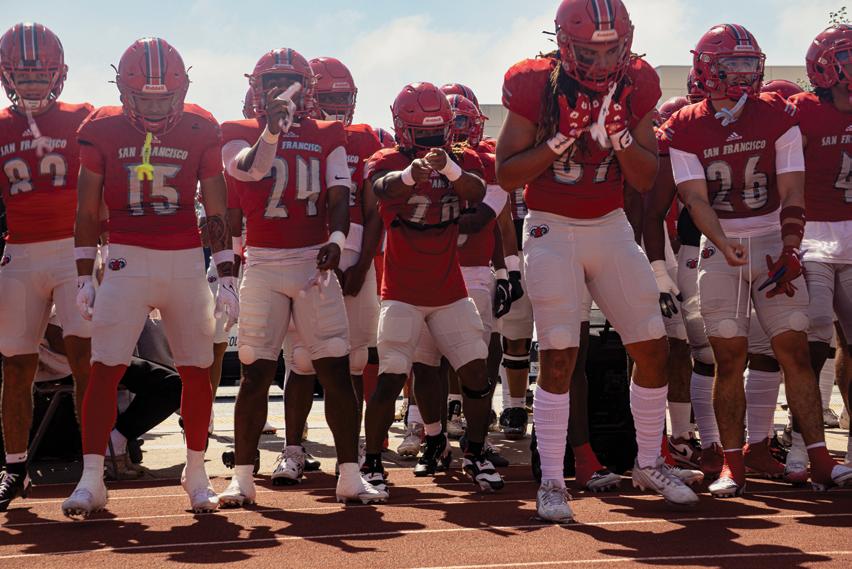The Guardsman
The Truth Shall Make You Free
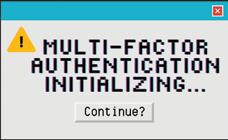

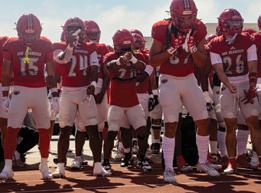




By John R. Adkins jradproduction@gmail.com
For nearly half a century, the modest force that formed El Tecolote has been shaping San Francisco newsrooms from a corner of City College. Most afternoons, Juan Gonzales sits among his students, trading story pitches and banter. Some merely pass through on their way to other majors, while others continue to return year after year to the world that Gonzales built.
When Gonzales was first notified of his award, he didn't think much of it. He printed off the email and read it aloud at a Guardsman meeting, just as he does with any other press release. Awards blend into the walls of the newspaper headquarters. His own trophies gather dust in the backdrop behind his office chair.
The overlooked email, however, had notified the Journalism Department chair that he'd been awarded the Distinguished Teaching in Journalism Award by the Society of Professional Journalists. The honor is the top prize for journalism education in the country.
“It was actually shocking,” Gonzales said. “When I first heard, I thought it was a local award. And then, as I was told by the Society of Professional Journalists, this was a national award, given to only one person.”
For 40 years now, Gonzales has
served as chair of City College's Journalism Department, teaching core newswriting classes and advising its award-winning, studentrun publication.
“This isn't just well deserved, this is overdue,” said Alex Mullaney, a former Guardsman editor turned professor for the program. A young Mullaney once sought a career as a firefighter, but when he learned the fire department wasn't hiring, he enrolled in a Newswriting course with Gonzales.
“Juan told me I had a knack for it at the end of the class, so I continued the program,” Mullaney said. “Now it's time for the country and beyond to learn what we in San Francisco already know…”
Before stepping into the position at City College, Gonzales was already a pioneer in the local reporting scene. He helped to document the studentled protests at San Francisco State University in 1969, which, after clashing with police batons and riot gear, made history by establishing the nation's first-ever ethnic studies department.
Gonzales taught a course on media and Latinos in the groundbreaking new department, which eventually led to the creation of his newspaper, El Tecolote, in 1970. Now 55 years old, the publication has endured due to his knack for bringing people together and inspiring others.
However, being a part of the ethnic studies department painted Gonzales as a rebel in the eyes of other faculty members who did not want him to teach in the journalism department at SF State.
“They essentially blackballed me,” Gonzales said. “They said I wasn't mainstream enough since I was teaching ethnic studies, and I had gone to the other side.”
Years later, he received a phone call from the president at City College, who had caught wind of the local legend. There was an opening in the Journalism Department, and it came with being the chair.
“He said, ‘I want you to shape the program as you see fit,’” Gonzales said of their conversation at the time. “He had a lot of faith in me.”
In the spring of 1985, he became chair of the Journalism Department at City College.
Mentor in the Making
At the college, he found himself working alongside far more people than he ever had at El Tecolote, and discovered a passion for being there to watch them grow. Gonzales could recognize when a student showed promise and would respond by investing the time to encourage them.
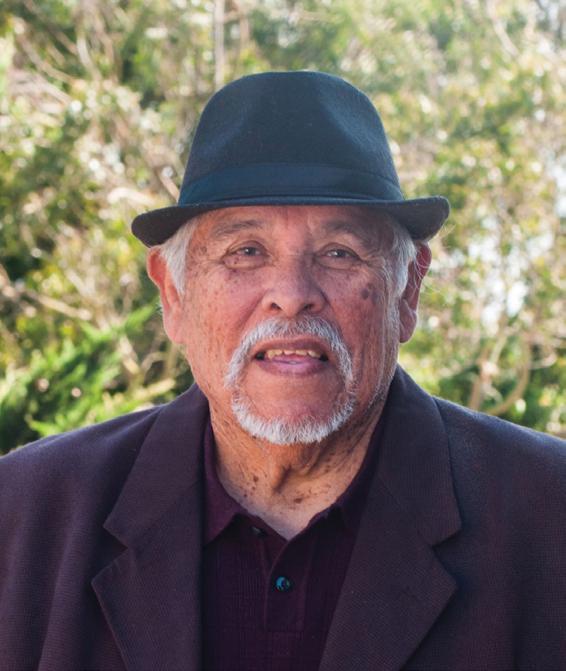
“I always found that, especially in a community college setting, you need someone to be there as not only a mentor, but as an inspiration, someone that's going to say things and do things to make them feel that it is possible,” Gonzales said.
Despite an accreditation crisis and the college's financial woes, The Guardsman has remained in its bolthole in the Ocean Campus Bungalows. In the heart of it all is Gonzales, often seen in his fedora and aviator shades, going out of his way to make himself accessible.
“He's there for his students, day in and day out,” Mullaney said. I think he had hip surgery back in the day, and he still came in. I don't think he even took a leave.”
By Marrion Cruz mcruz88@mail.ccsf.edu
T.J. Lee-Miyaki, a former student and president of the Associated Students Executive Council, has been complaining about disability access at the college for years.
“ADA should be prioritized — any little block will stop someone from getting to class, but the college treats it like any other maintenance ticket,” Lee-Miyaki said.
He has repeatedly raised issues with the Board of Trustees, from broken automatic doors to handicap bathrooms being used as janitors' closets.
“It takes four to five months to fix that door in the Harry Britt Building, and then it only works for a couple of days,” Lee-Miyaki said.
City College is required, under Sections 504 and 508 of the Rehabilitation Act of 1973, the Americans with Disabilities Act
of 1990 and the ADA Amendments Act of 2008, to provide equal access to academic programs and services to students.
Through Disability Services and Programs for Students, City College does offer accommodations that range from classroom relocation and captioning, to adaptive technology like lockers, scooters and note-takers.
For Douglas Winston, a health major at City College, access to education begins at the DSPS office.
Winston starts the process by meeting with his counselor before each semester. The inclement weather form excuses him from in-person classes and provides a remote option — in his case, Zoom — because the rainy season makes it

illustration by John Adkins
hard for him to commute, citing his electric wheelchair.
“The professor of the class told me that wasn't something she could help with,” he said. “But I knew where to go.”
The DSPS front desk, located in the new Student Success Center, often sees students arrive with questions ranging from appointment scheduling to assistive technology.
Still, students like Lee-Miyaki point out that systemic problems remain.
Diana Moore, a student at City College, has been relying on DSPS services for three years to attend classes. “It's a good program, but the door to the actual DSPS office is not ADA compliant,” Moore said. “Somebody has to hold the door for me to get in and out.”
Relying on the scooter loan system at the DSPS requires students to sign each scooter out at the end of every school day, which Moore says
provides yet another obstacle to her accessibility.
Both Moore and Lee-Miyaki described fears of parking tickets from campus police while using disabled placards.
“Over at Cloud Hall, the area says employee parking,” Moore said. “I just park over there anyway, but so far so good, I haven't got the ticket.” Winston expects to complete his associate's degree in Health Counseling in 2027, provided he continues to receive aid from the DSPS.
“The help for access is always there,” Winston said. “If one counselor is not available, another is,” he said, looking at his appointment card. “After getting into DSPS and its programs, it's really up to the students to follow through to obtain the program benefits.”
For Lee-Miyaki, the urgency is clear: “Access is not a one-time fix.”
Staff
Editor-in-Chief
John Adkins
News Editor
Tabari Morris
Culture Editor
Abby Sigler
Op-Ed Editor
Henry Crowell
Sports Editor
Lloyd Cobb
Social Media Editor
Abby Sigler
Photo Editor
Isaac Ortiz
Copy Editor
John Adkins
Writers Ahmad Aimaq
Cain Gibson
Cooper McDonald
Finbar LaBelle
Karla Lopes
Lev Farris Goldenberg
Marrion Cruz
Qi Mai
Raeghan Green
Victoria Capree
Photographers
Karim Farahat
Tiffany Sainz
Illustrator
Cindy Chan
Graphic Designers
Cindy Chan
Sebastien Thugnet
Tiffany Lam
Advisor
Juan Gonzales jagonzal@ccsf.edu
Contact us
TheGuardsman.com info@theguardsman.com (415) 239-3446
Mailing Address
50 Frida Kahlo Way, Box V-67 San Francisco, CA 94112 Bungalow 615
Follow us

@TheGuardsmanCCSF

@TheGuardsmanCCSF


@TheGuardsman
@TheGuardsman
For even more articles, stay up to date at www.theguardsman.com

Join The Guardsman!
Contact Juan Gonzales at 415-517-4426.
By Tabari Morris tmorri47@mail.ccsf.edu
City College is preparing for a new and needed upgrade to its student and staff portal.
According to Chief Technology Officer Patrick Ekoue-Totou, the changes are driven by the need for advanced security features and a better user experience. He stated that the current vendor of the myRam portal has not maintained the system to his standards, particularly in terms of interface and code updates.
“The portal that we currently have is doing its job, but times have changed. We are seeing improvement across the board from a lot of our peer institutions,” Ekoue-Totou explained.
The focus of the planned overhaul is to have an improved multifactor authentication system. Unlike the current system, which requires users to verify their identity every time, the proposed “Smart MFA” will recognize trusted conditions — such as repeated logins from the same device and browser.

“That creates a level of annoyance for my users that I really want to get rid of,” Ekoue-Totou stated, emphasizing that the new technology must be both secure and user-friendly.
If a user's login environment suddenly changes — say, logging in from another country — the new system will require additional verification. “Those are the things that create flexibility and ease for the users. And currently CCSF doesn't have that functionality, and that's something I intend to put in place as soon as I can,” Ekoue-Totou said.
When asked about training and communication, Ekoue-Totou assured the college that there would be broad outreach. “We'll do multiple announcements before deployment, and continue communications when the change occurs,” he said.
A hotline is planned for support; however, staffing challenges may impact phone assistance.
“I've done this at other colleges, and it went smoothly. Some challenges I've seen are when users have antivirus or privacy rules that interfere with the MFA,” he added.
Ekoue-Totou is confident that the
college will adapt quickly, but recognizes that some community members may need more help — something his department is working to address. Meanwhile, student and faculty access to Canvas will remain unaffected, as the portal acts as the gateway to other services. EkoueTotou confirmed that users will continue to authenticate through the myRam portal before accessing apps like Canvas, without the need for repeated logins.
While it is still too early for specific user instructions, Ekoue-Totou made it clear that careful planning is underway to select the best technology solutions. However, he also acknowledged a continued staffing shortage in the department.
“We are working with the leadership to see how we can rightsize the department and make an effort to provide adequate services,” he said. Moving forward, the campus community can look forward to even more improvements as feedback shapes future updates to the myRam portal, with the goal of making it safer and more efficient.
By Lev Farris Goldenberg lfarrisg@mail.ccsf.edu
City College needs to attract more students. Specifically, the college must raise its enrollment rate by 8,000 full-time equivalent students in order to avoid a State funding freeze that was set to take effect this school year.
In an effort to advertise via social media, City College has turned to AI.
Between April 12 and June 8, the City College Instagram account (@officialccsf) posted 73 times. Approximately 54 of those posts appear to have characteristics of AI-generated images.
A review of several of the posts by Sightengine, a top-ranked AI-image detector, found that the images had a 99% chance of being AI-generated. Sightengine also found that the images were likely generated by GPT-4o, a generative AI program developed by OpenAI.
However, the college denied the use of AI-generated images in its marketing or social media content.
“When creating promotional content, the College prioritizes authentic representation — using actual photos and videos of our students, faculty and campus whenever possible,” said Alexandra Céspedes Kent, the college's media spokesperson.
On Sept. 11, the @officialccsf Instagram account posted a Reel featuring footage of the new Student Success Center spliced with two videos of students that appear to be AI-generated. The video, advertising City College's College Fair, is narrated by an artificial-sounding voice.
The college's 2024-26 Strategic Enrollment Plan noted that “marketing will play a crucial role in the strategic enrollment plan because it directly influences the four core focus areas … recruitment, retention, completion, and partnership, and the overall reputation of the institution.”
Most of the posts between April and June advertised courses

available during the 2025 summer and fall semesters, including Financial Accounting, Intro to Programming, Beginning Photography, Spanish 1A, Basic Drawing and more.
Several of the posts contained cut-off images or misspelled words and phrases. An image advertising Beginning Photography cut off most of the word “Beginning.” Another post about a summer custodial training course advertised “preparing you for rel-world (sic) jobs in schoolshospitals, offices, and upblic (sic) buildings.”
Other seemingly AI-generated posts included incoherent hashtags such as “#CCSFummer” and “#CCFSummer.”
The City College Instagram feed during this two-month marketing push is full of young, happy, perfectly clear-skinned AI-generated students. A post advertising IDST 80C (Diversity and Social Justice: Sexism) features four smiling, AI-generated people of varying diverse backgrounds.
In a post advertising the College's
Culinary Arts department, an image of an AI chef slicing an AI carrot does not mention where or how to register for the program's courses. The post has no caption.
At a time when City College needs to be attracting real students, the College has chosen to advertise with fake ones.
In 2023, City College contracted with ASIR Visual Marketing to beef up its recruiting efforts. ASIR would provide “marketing, branding, design, and media buy to build a custom brand in order to market and promote FREE CITY to the community and residents of the City and County of San Francisco.”
This July, a City College purchasing report stated that ASIR would “develop messaging, campaign theme, design all creatives for digital media buy, high school outreach posters, etc.” For its services, the college paid ASIR $99,500 to “design, develop, and execute Fall 2025 Campaign for CCSF.”
According to Vice Chancellor Lisa Cooper Wilkins, City College
terminated its relationship with ASIR, but did not clarify when by press time.
Dr. Wilkins told The Guardsman that ASIR did not use AI to generate images or videos for the college.
In ASIR's scope of work marketing proposal for 2023-26, submitted to City College in 2023, the company promised to “design artwork for all needed organic and paid postings for all social media platforms and streaming services.” As of November 2024, City College did not have an internal marketing department.
When COVID-19 dropped enrollment rates in 2020, a statefunding measure known as “Hold Harmless” allowed City College to receive funding for more students than it had enrolled.
Starting this academic year (2025-26), the State will no longer apply cost-of-living increases to the college. This means that state funding for City College will freeze at 2025 levels as costs continue to rise.
If City College can add enough full-time students (8,000), it will receive state funding that accounts for the rising cost of living.
According to the school's Enrollment Management Committee, student enrollment for the Fall semester totaled 19,159 as of Sept. 18. In the Fall of 2024, City College had 19,688 enrolled students.
The most recent Reel on the City College Instagram features culinary arts student Bianca Cardenas working on campus, crafting desserts and interacting with other culinary students.
“For me, not having to worry about tuition is a big relief,” Cardenas said in the non-AI-generated video. “But City College is about more than free tuition — my instructors and mentors care about me.”
Visit theguardsman.com for updates to this story.
Every semester, Gonzales sends out his students' stories for competition, maintaining that it should be the faculty's responsibility to take the initiative. He acknowledged the work required to stay up-to-date on deadlines and file submissions, and when the awards flood back each time, Gonzales says it's a testament to the training they received from his department.
Gonzales recalled his own beginnings working for his high school newspaper, when he won an honorable mention after his advisor submitted his writing to the San Francisco Press Club contest.
This was Gonzales' first award. “My whole sense of value and confidence just blew up,” he said, blinking back the tears. “If some professional out there feels I have some talent, then I'm gonna stick with it. And that's what I did, it was the recognition that I had worth.”
Jessica Lifland, a photojournalism instructor in the department for 20 years now, said he has a way with his staff just as he does with his students. “He knows me, and he lets me be me,” Lifland said.
His faculty are as loyal to him as his students are, inspired by his dedication to the individuals who walk through his door.
“Teaching is all about service to people, helping people make a
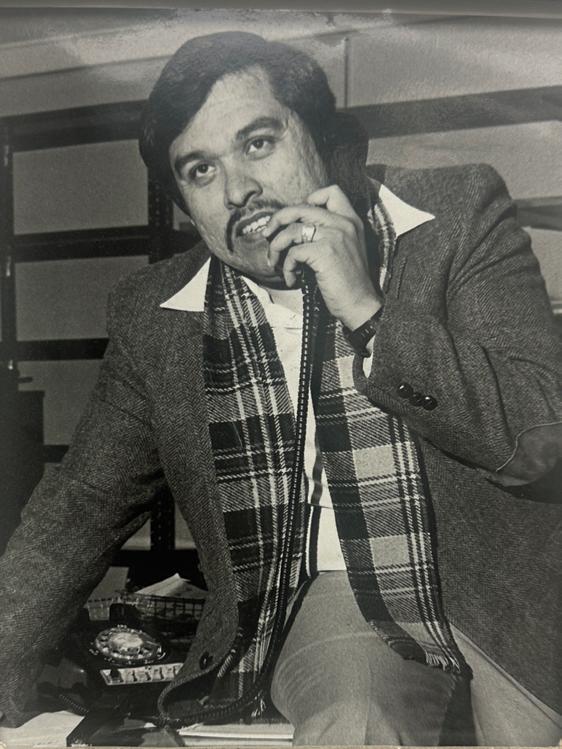
difference,” Gonzales said. “And I think that's what instilled in me that this work was not too far from what I was doing with El Tecolote.”
Over time, Gonzales realized that through teaching, he could make an even greater impact than he did with his articles.
“When you write a story, you don't always know if you're touching people or making a difference,” he said. “But when you're in a classroom and you see the people in front of you, and you see them move on and what they do after, you get a sense that you did make a difference, and it was all worth it.”
Ask any working journalist in San Francisco where they got their start, and Gonzales' name surfaces.
He can rattle off a long list of writers and storytellers who all got their start on The Guardsman before going on to work at publications like The New York Times, The Atlantic and The Washington Post.
Joe Fitzgerald Rodriguez, president of the Society of Professional Journalists Northern California chapter and a senior politics reporter for The San Francisco Standard, also got his start on The Guardsman, where he served as editor-in-chief and pushed his staff to compete with The San Francisco Chronicle.
“I'm a proud protege of Professor Gonzales,” said Fitzgerald Rodriguez. “He taught me to talk to everyone — janitors, secretaries, families — not just those in power. More than a decade and five journalism jobs later, I still remember how he taught me to always center community, and to center people, in my coverage.”
Inspired by the path that Gonzales walked before them, many of his students have started their own newspapers in San Francisco, which still exist today, including Sunset Beacon, Richmond Review and The Ingleside Light.

“San Francisco's journalism community cares more for the people who live here because of Professor Gonzales. His impact will reverberate immeasurably, decades after he retires…” Fitzgerald Rodriguez said.
The award comes at a time when, after 40 years of service to City College students, he is finally planning to retire. However, his commitment to students has no end.
Wherever they are in their careers, his former students all know he's never too far from his phone, and they can always call on him when they need him.
“As long as I can breathe and talk, I'm willing to give advice,” he said.
Gonzales' wish is that whoever takes his place as the Journalism Department chair will recognize the value of engaging with students and build on the atmosphere he's worked so hard to develop.
“Juan has built a dynasty, really. I'm just glad I was able to go along for the ride,” said Lifland.
Gonzales will be flying to Washington, D.C., alongside Alex Mullaney, to receive his award at the Society of Professional Journalists national convention on Oct. 15.
“You never plan to be a good teacher to get awards and honors,” Gonzales said. “You teach because you love it, and you want to make a difference in people's lives. To be honored like this is just gravy.”
When asked if he had one message to students considering getting into Journalism today, Gonzales replied without hesitation:
“Every story you write is a piece of history. You're delivering information to people that will be used for years to come. If you have at least an ounce of passion for journalism, if any of that excites you, then give it a shot. Get the skills. Be that storyteller for the next generation. Learn to write, learn to research and learn how to meet people and conduct interviews. You can use those skills in almost any field, so don't discount it. Give yourself that opportunity.”
Much like when he won his first award back in high school, Gonzales can now close the book on his teaching career with the confidence that not just one, but thousands of professionals across the nation recognize the contributions he's made to the field, as well as the generations of reporters now writing the history of America that owe Gonzales their careers.
By Karla Lopes kcarval7@mail.ccsf.edu
At City College, there is no universal policy on the use of generative Artificial Intelligence in the classroom. Instead, faculty members are instructed to decide for themselves and communicate their expectations, raising debates over consistency, fairness and academic integrity.
AI is reshaping education, and its use is increasing among students in higher education. According to a 2024 global survey conducted by the Digital Education Council, 86% of higher education students reported using AI tools in their studies. The survey also reported that the most frequent uses of generative AI are for searching information, checking grammar and summarizing documents.
Higher education institutions are forced to adapt to the rapidly evolving landscape of AI. The City College Academic Senate recognizes that there is no single correct way to approach AI within classrooms; rather, individual instructors must choose to incorporate, limit or prohibit the use of generative AI, adapting it to the realities of their
courses, while clearly communicating this approach to students in their course syllabi.
Jonathan Potter, chair of the Computer Science department, agrees with the college's position.
“I think it's good right now that we don't have an institutional policy,” Potter said. “It varies so much from course to course, so it's good that the institution is taking a step back.”
Potter allows the use of AI in his own courses, recognizing that CS students must learn how to utilize it as a means to further their learning.
On the other hand, English teacher Chanté McCormick says the lack of a clear institutional guideline makes it difficult for instructors to have an effective approach to AI in the classroom, and that discussion on the topic is frequent among English teachers. “It is a lot of crowdsourcing

when it comes to how we are going to approach this,” McCormick said.
McCormick prohibits the use of AI for assignments, explaining that composition classes require input from someone real, not from a large language model. Despite believing in the potential benefits of AI tools in various tasks, she emphasized that students must still achieve the course's learning goals, which include developing their own original writing skills.
The Visual Media Design faculty has developed its own departmental policy regarding AI use, which varies according to the course. “We have actively incorporated instruction using AI, as it has fundamentally changed production workflows in our industry,” said David Stevenson, a Visual Media Design instructor. However, in specific class scenarios where instruction is more focused on non-digital content, Stevenson maintained the need to encourage students to engage in their own critical thinking and writing without relying on AI.
City College offers a range of tools and materials to support both instructors and students in utilizing AI in the classroom. The college website offers access to
City College's Library Guidelines for Citations Including AI, a resource that helps students learn how to cite AI-generated language using the Modern Language Association (MLA) or the American Psychological Association (APA) format.
Section 8 of the Student Code of Conduct addresses the issue of intellectual dishonesty, plagiarism and the use of generative tools without the instructor's permission. That same section highlights that “a student may not use generative tools to produce content that the students submit as the students' own thoughts and/or language.”
However, some faculty members believe that not having a universal policy means the college is choosing not to acknowledge the impact that AI usage has on students' learning experiences.
Social Sciences instructor Alexandra Nickliss believes that the college should conduct thorough vetting and analysis before instructors adopt AI for any classroom use. Nickliss hopes for a college-wide policy that “focuses on human intelligence, critical thinking skills and fact-based knowledge.”
By Abby Sigler abby.sigler@gmail.com
Tufted yarn climbs toward the ceiling and spills onto the floor of the City College Art Gallery. Students glide their fingers across the touch-friendly pieces by the entrance.
This exhibit, titled “Vivid Visions,” features a mix of acrylic
paintings and textile installations created by San Francisco-based artist Jennifer Banzaca. The colored yarn cascading from the gallery's largest wall is the collection's centerpiece, titled “Rise UP!”. This is the first exhibit of the semester for the gallery, running from Sept. 8 to Oct. 9.
During the opening reception on Sept. 17, more than 40 students and art-lovers flowed in and out of
the gallery, admiring Banzaca's work.
“It's like a candy store,” said longtime student John Friedberg, gesturing to the room awash in bright greens, pinks and blues. “I go to a lot of galleries, and it's hard to find art that makes you feel this good.”
The positivity behind the show was no accident. “For this, I wanted to create something uplifting,” Banzaca explained. “I had the

By Karla Lopes kcarval7@mail.edu.ccsf
On a warm Saturday afternoon, while the city buzzed outside, a crowd of more than 60 film lovers quieted their chatter and gathered within San Francisco's Roxie Theater.
It was Sept. 20, the second day of the Studio 8 Film Festival. The three-program celebration featured works by San Francisco Art Institute alumni and faculty, including filmmaker and City College cinema professor Denah Johnston.
The festival aimed to spotlight SFAI alumni and welcomed several for a post-screening Q&A. However, attendance fell short compared to last year's Kuchar Brothers tribute at the same venue. “That was a little disappointing," said festival organizer Maria Theresa Barbist. “We hope to do more outreach to schools in the future.”
With a three-hour duration, the exhibition's second day displayed a jury open-call selection of short experimental films, dissected into three programs. The first segment featured the works of the open call jurors, Deborah Fort, Toney Merritt and Christopher Coppola. Program two honored the life and
work of the Swedish filmmaker and late SFAI faculty member Gunvor Nelson, who died earlier this year. Finally, the third program featured the open call selected films submitted by SFAI alumni and former faculty, including Johnston's experimental film, “Flux” (2003).
The audience was immersed in a rich sensorial journey, with an interesting and compelling audio-visual experience that varied in media, techniques and themes, as a true celebration of independent filmmaking.
Directed by John Muse and Brendamaris Rodríguez, “Giroscopio” (2021), the contest winner, explored sensory disorientation through the movement of bodies and objects spinning. Made during the COVID-19 lockdown, the film reflects a world in disoriented motion.
“My experience was really nice, I feel like it was really relaxing to see all the different stories,” said attendee Strawberry Corey, 30. Corey also highlighted the diversity of audiovisual experiences: “What stood out to me was all the different visuals; I could tell the different cameras they used.”
“Flux” (2003) is a six-minute, black-and-white short film, shot in 16mm, that brought intriguing
idea that we're all kind of down in the mud — so let's lighten the mood a little bit, let's make it a positive experience.”
Few of the works are conventional. Of the three that are framed, Banzaca treated the frame itself as part of the composition, airbrushing gradients along the edges. This way, brilliant colors are visible from every angle. “I like thinking of the painting as a total object, which is why I paint the frames. It's all one piece,” she said.
Banzaca described “Rise UP!” as her most significant accomplishment in the show. “This is my largest piece to date,” she said. “I had the image of this room in my mind while I was making it, and I liked the idea of creating a fluffy mural.”
Nature remains a steady source of inspiration for her, saying she looks to the “botanical shapes and clusters” in the world around her.
Formally trained as a painter, Banzaca began experimenting with tufting during the pandemic after seeing videos of the technique on social media. “When I tried it, I became intrigued by the way I could paint with the yarn, and it really broke me out of the format of a canvas, square or rectangle,” she recalled.
Banzaca described how the textures she can achieve through tufting lend themselves well to the nature motif. Color is another defining feature of her work. “I always gravitate to really saturated colors,” she said with a laugh. “I'm not big on beige.”
The San Francisco art
community has also helped shape her trajectory. After spending years in the competitive environment of New York's art scene, she found the Bay Area to be more open.
“People are interested and they're engaged… and there's more freedom here to experiment,” Banzaca said. That freedom recently took her to an artist residency in Sicily, where she absorbed the patterns and carvings of Italian architecture through her sketchbook.
The City College Art Gallery's relocation to the STEAM building in January has brought fresh visibility, attracting students from both the arts and STEM disciplines who might not otherwise visit a campus gallery.
“This was a lot more than we usually get,” student gallerist Sam Carmel said, gesturing to the crowded opening.
For anyone who stops by to see her work, Banzaca hopes they will leave feeling inspired to be more expansive in their studies and to think outside the confines of a canvas. “I hope people get a sense of being uplifted, excited,” Banzaca said.
“Vivid Visions” is on display at the City College Art Gallery through Oct. 9, located on the first floor of the STEAM building. Admission is free and open to the public.
Gallery hours are Mondays 10 a.m.-1 p.m. and 2 p.m.-6 p.m., Tuesdays 10 a.m.-5 p.m., Wednesdays 12:30 p.m.-6 p.m. and Thursdays 12 p.m.-6 p.m.
cinematic elements to the crowd. Without dialogue, the film features a woman wearing a polka dot dress wandering, and at some moments, sleeping, on a rooftop. The sounds of heartbeat pulses and windblown chimes, along with visuals marked by whiteouts, create a dreamlike imagery.
“The process of making ‘Flux’ was not a linear thing,” said Johnston, “I think I was more interested in seeing what would happen.” At the time, Johnston was working primarily with found footage, remixing and remaking films, so “Flux” marked a departure from that approach. With its experimental form and non-linear structure, the making of “Flux” was, as Johnston put it, “very organic and spontaneous.”
“Flux” took Johnston on a journey of taking creative risks by putting the film inside buckets with chemicals, like stirring spaghetti, which can create unpredictable visual effects, such as the whiteouts that give the short its dream-like imagery. That said, the creation of “Flux” was more focused on the process than on its original intention. “It is about the journey, not the destination,” Johnston highlighted.
Since joining City College in 2015, Johnston has found little
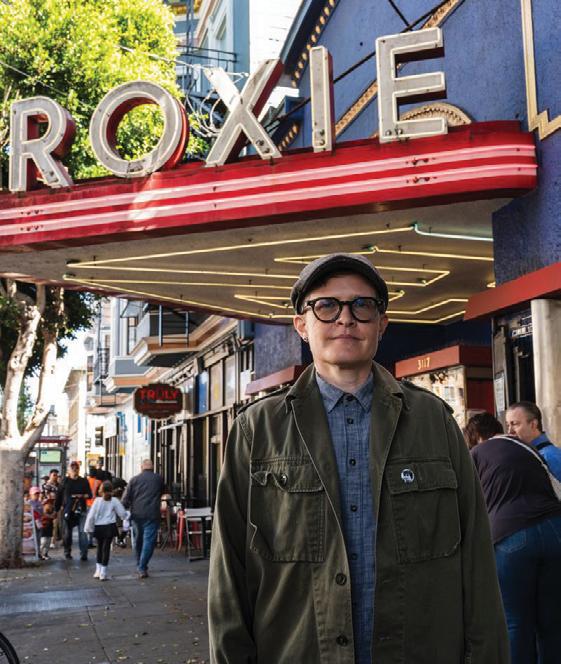
time to work on personal creative projects. “I was only able to produce new work during my sabbatical in 2023.” Johnston still plans to finish some projects from that sabbatical and believes that instructors should keep creating, giving students a chance to experience the process firsthand, and be inspired by it.
Overall, the Festival showcased original and creative works from local independent artists, and, in Johnston's opinion, this is “truly valuable” because it demonstrates how accessible experimental filmmaking can be, encouraging others to try it.

By Raeghan Green greenraeb@gmail.com
Nearly 80% of college students work while enrolled in classes, according to the U.S. Bureau of Labor Statistics. This balancing act pushes many to master time management as they split their days between lecture halls and hustling for paychecks.
“I was working thirty hours a week while finishing my degree,” says 22-year-old City College student Allie Duke. “It was the hardest thing I've ever done.”
In San Francisco, where the cost of living is 65% higher than the national average, many full-time students are forced to either cut back on study hours or reduce their course loads. The impact is visible in classrooms. “I've had at least one student a semester drop for work obligations or travel,” says World Languages professor Aaron Avila.
The question is: how much work is too much, and what support exists for students trying to balance both worlds?
At City College, several resources are available. Through the Student Services section on ccsf.edu, students can access financial aid guidance, counseling and retention programs designed to help them stay on track academically while managing outside responsibilities.
The availability of asynchronous online classes also provides flexibility. “Thanks to the internet, students who need to travel can still access homework and tests,” Avila said. The college's Office of Online Learning and Educational Technology supports students who may not be able to commit to traditional, in-person classes.
OLET offers resources that help students transfer to four-year universities, earn Associate Degrees in Arts and Sciences, and gain certificates and career skills for workplace success. It includes CityOnline and the Educational Technology Center, both of which are part of the Educational Technology Department.
CityOnline enables students to take online classes from San Francisco or anywhere in California, offering a highly regarded transfer program designed to fit around busy lives and work schedules.
The Educational Technology Center offers training and support in educational technology and its applications to City College students. Visit the Canvas Student Support Center for resources that support both credit and non-credit students in their online learning.
Despite these tools, balancing school and work often comes down to personal resilience and determination. “I learned how to prioritize and manage my time, but it definitely helps that I took predominantly online classes,” Duke said. “I would disperse my work throughout the week, completing most of it on my off days and the rest at night. It wasn't easy, but it taught me skills I'll use for a long time.”
Students can also benefit from practical tools. A planner — physical or digital — can help keep schedules organized, and free apps like Google Calendar can send alerts for assignments and deadlines. Avoiding procrastination can ease stress, while open communication with professors and employers can help prevent conflicts. “I always attempt to accommodate unexpected absences and work responsibilities,” Avila said.
For many students, the balancing act isn't easy. But with the right support, strategies and persistence, it can pay off long after graduation.
SUN 12
World of Dumplings Festival
11:00 a.m. - 5:00 p.m. | Ferry Building
SF's Annual Italian Heritage Festival & Parade
12:30 p.m. - 3:00 p.m. | Fisherman’s Wharf
TUE 14
CCSF Women's Soccer vs. Chabot 4:00 p.m. | Soccer Field, Ocean Campus
SparkPoint's benefits Enrollment Day 1
12:30 p.m. - 4:30 p.m. | Student Success Center, Room 2106
WED 15
Equity talks: Dr. Willie blackmon 10:00 a.m. - 11:30 a.m. | HBB, Room 140
Photo lecture Series: lupine Hammack Creative
6:00 p.m. | STEAM, Room 101
CCSF Women's Volleyball vs. West Valley 6:30 p.m. | Wellness Center, Ocean Campus
THUR 16
SparkPoint's benefits Enrollment Day 2
8:30 a.m. - 4:00 p.m. | Student Success Center, Room 2106
FRI 17
CCSF Women's Volleyball vs. Skyline 4:30 p.m. | Wellness Center, Ocean Campus
SAT 18
CCSF Football vs. laney College 1:00 p.m. | George M. Rush Stadium
SUN 19
Shipyard Fall Open Studios 10:00 a.m. - 12:30 p.m. | 451 Galvez Ave
MON 20
Wellness Day @ Mission Center 11:00 a.m. - 6:00 p.m. | Mission Center
TUE 21
CCSF Women's Soccer vs. Cañada 1:30 p.m. | Soccer Field, Ocean Campus
CCSF Men's Soccer vs. Cañada 4:00 p.m. | Soccer Field, Ocean Campus
Wellness Day @ Evans Center 3:00 p.m. - 4:00 p.m. | Evans Center WED 22 CCSF Women's Volleyball vs. San Mateo 4:30 p.m. | Wellness Center, Ocean Campus Wellness Day @ Downtown Center 9:00
Have an event you want featured in The Guardsman? Send an email about it to abby.sigler@gmail.com

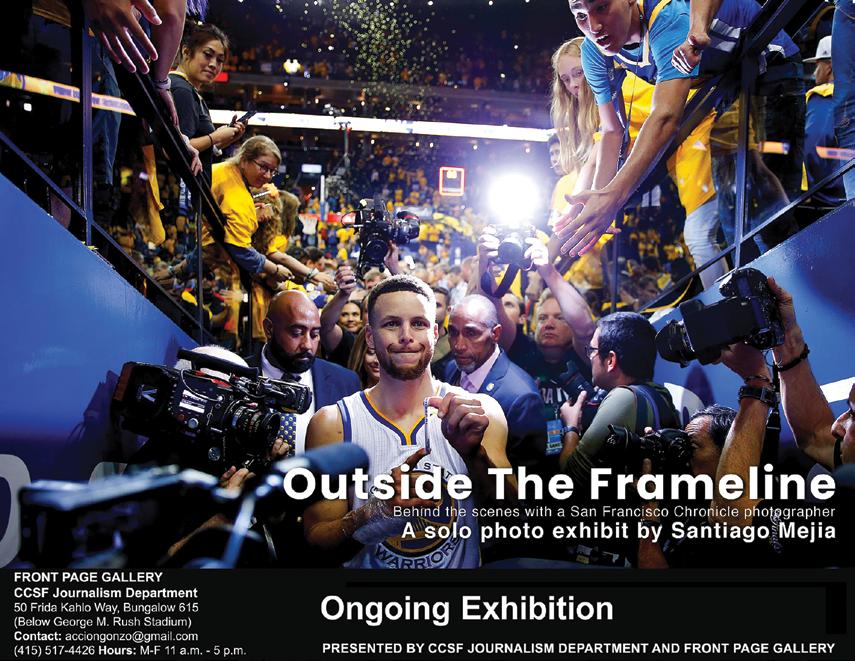

By Karim Farahat karim.farahat0823@gmail.com
Lowriders cruised from across California to gather on Mission Street for the King of the Streets Lowrider Event.
On Sept. 20, nine blocks on Mission Street were closed off from 1-8 p.m., between 18th and Cesar Chavez streets, allowing the proud owners of decked-out lowriders to roll out.
Lowriders are an important aspect of the Chicano community, as they serve as a means of expressing individuality.
“Everybody's car is different, and everybody wants to show off what they did to their car,” said José, the owner of a 1957 Chevy Bel Air.
Lowriders can now enjoy a
primetime celebration on Mission Street, but their mainstream acceptance did not come easily.
Given the cultural importance, lowriders have not been deterred by the arrests made over their cars.
Roberto Hernandez, founder and president of the San Francisco Lowrider Council, has been beaten by police and arrested 113 times.
Hernandez filed a successful lawsuit against San Francisco in 1979 to contest the injustices that lowriders were subjected to. Several years later, after rejecting the city's cash payout, lowriders were granted the right to cruise, marking a turning point in the broader acceptance of lowrider culture in the Mission.
“They literally criminalized us for enjoying good cars and good company, so the fact that they have
allowed it and for the first time it's televised, this is a beautiful thing,” said Mila, a Mission native and owner of a 1964 Buick Rivera. “It's an acceptance of our culture.”
With the tradition being passed down from generation to generation, some cars are continuously worked on for decades, reaching upwards of $100,000. Each car embodies the lifestyle and personality of the owner.
“We grew up with this as kids,” said Ivan Meza, owner of a 1981 Chevy Caprice. Meza drove from Fresno to represent Just Dipping Car Club. “This is something that was passed down from older family members, like my uncles, my brothers, and then I passed it down to my son, my nephews, it keeps going,” Meza said. “This is tradition.”


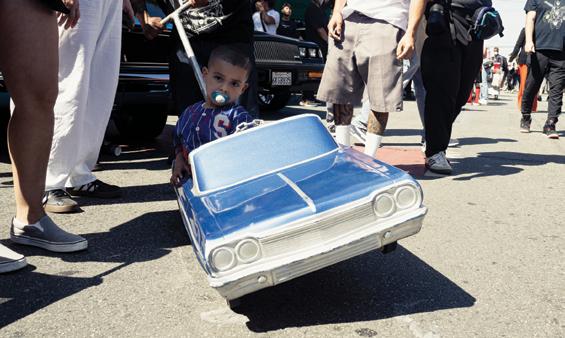
By Kristian Mitchell kmitch79@mail.ccsf.edu
In a Gallup poll last year, it was discovered that only 31% of Americans placed “a great deal” or “a fair amount” of trust in mass media, while 33% chose “not very much” and a shocking 36% answered “none at all.” Gallup has been tracking public confidence in the media since the early 1970s, and this is the lowest it has been in the last five decades.
I am someone who believes in the importance of media for society, a necessary tool to keep the masses informed on issues that directly affect all of us in our day-to-day lives. It has the ability to steer public opinion on what is happening in the world, as well as keep people informed enough to form their own minds and opinions.
The news and media at large help people with small everyday questions, such as “Will I need a jacket today?” to complex issues like “Why are my tax dollars being used to murder children on the other side of the world?”
Over the past two years, I have watched U.S. media lie and attempt to manufacture consent for what many holocaust scholars and human rights organizations are calling a genocide, paid for by our tax dollars. Constantly, we have been directly told lies about what the U.S. government was doing to end the bloodshed, “working tirelessly around the clock” to deliver a ceasefire in Gaza, and there has not been even the slightest bit of critique from the U.S. media, until within the last few months.
We can easily see the truth of what is happening with a few taps on our phone and watching the unimaginable horror happening to Palestinians, and see in real time that our media institutions are not doing their duty of informing people, and are purely spreading propaganda directly from the U.S. state department.
A 2024 Pew Research Center poll found, 54% of adults in the US get their news “at least sometimes from social media,” and in another

Pew Research Center poll, data shows that Americans want honesty and authenticity from their news providers, so as people are learning that the institutions that we have long had faith in are not actually serving us, but rather feeding us false narratives, omitting key details and information, and not operating in the interest of the people, we are seeing people shifting away from these legacy institutions.
I think this is not an issue, but
an opportunity, as it gives people a chance to be more naturally critical of the information they absorb, and it is also a wake-up call for our institutions to do their job and serve the public, helping to educate the masses.
Regular people often lack the authority to question those in charge. The odds of us “average folks” ever getting near a world leader or an elected official are already low, let alone being in a setting where
we can ask those officials about the work, or lack thereof, they are doing in the office that we elected them into. That is the power of our media institutions, and we depend on them to do what is necessary.
However, blindly following orders and telling people what the State Department wants them to hear is a disservice to the general public, the audiences of these institutions.
By Karla Lopes kcarval7@mail.ccsf.edu
Ibelieve in the transformative power of education. In Brazil, where education is understood as a fundamental human right, free access to universities allows many, especially from working-class and marginalized communities like Black and Indigenous Brazilians, to improve their social and economic conditions.
I was surprised to realize how expensive higher education can be in the United States, and that it is very common for students to be in debt, which can be a significant barrier for many to pursue higher education. And although I believe Brazil's educational system needs more improvement and investment, compared to the United States, I still believe that the Brazilian system of
free access to education changes the reality for thousands of people.
Having lived in San Francisco for three years now, I understand why some people say we live in a bubble compared to many places in the U.S.
The Free City program is a good example of that. I was surprised to learn that the city offers free higher education to its residents, and here's why I believe San Francisco should continue funding Free City.
Education must be a fundamental human right, not a privilege. By offering free access to higher education, especially for low-income residents, San Francisco works towards the democratization of education, as higher tuition costs can be a significant barrier to educational opportunities for many people.
Luna La Mantia, 22, Psychology student, is in the Free City program and said that the program “helps
students who probably don't have that many privileges, and struggle a lot because they don't have enough resources.” She also pointed out that the Free City has helped her connect to other kinds of programs, like the Harts Program, which offers students housing support.
Naomi Bush, 30, is an engineering student. She has been supported by Free City and highlighted, “It helps me with basic things like gas, school, food and housing.” In addition to that, she also gets child care support, which helps her a lot as a single mother and student.
Knowledge is a powerful tool for liberation and social transformation. Throughout history, many social groups have been excluded from society and subjected to awful treatment. In many cases, we can see how knowledge and access to education were utilized by oppressed
groups as a means of liberation and social transformation, changing the reality of individuals and entire communities.
In Brazil, affirmative action plays an important role for Black, Indigenous and low-income people to enter universities. Many of them decide to create and lead community projects or join social movements to fight for equity in education. The National Union of Students (União Nacional dos Estudantes or UNE) is a great example of that.
UNE was founded in 1937 and represents around six million students across all Brazilian states. The union has played a crucial role in fighting for free, quality higher education, increased government investment in education, and better policies to help students access undergraduate and graduate education, such as the affirmative actions
mentioned before. It is a movement formed by students, and for students, because they understand how powerful and necessary education is.
Last, I believe the more diverse a college or university is, the better. To open the City College doors for a more diverse public, including people who have been historically denied access to education, City College is not only guaranteeing them the opportunity to learn, but also to produce and share new types of knowledge, which sometimes breaks the pattern of making and displaying one dominant kind of academic production or worldview.
By providing students with opportunities, we can enrich academic research, which, in my view, can have a profoundly positive impact on society.

By Lloyd Cobb lcobb10@mail.ccsf.edu
The score was 28-10 late in the second quarter, with Sierra College in the lead, when everything shifted.
On the sideline, head coach Eduardo Nuño calmly called adjustments. “The offensive line took over,” he said after the game.
From there, the tone flipped. Receivers absorbed punishing hits that made the bleachers gasp — but instead of breaking, those collisions only fueled up the Rams. Tight end Keion Goodwin tied it back to their practice: “Practices are intense, fast, physical,” he said.
Then came the ignition. “We just went turbo,” Goodwin said.
From that moment, the Rams erased an 18-point deficit and buried Sierra with a 38-0 run, solidifying a 48-28 victory.
Quarterback Darius Clark-James kept it simple: “Clean, physical football. Give receivers a chance to play. I trust my receivers to make plays.”
He backed it up, completing 21 of 32 passes for 304 yards and two touchdowns while running for two more. He spread the ball to nine different receivers. Jeremiah Nash led with 135 yards on four catches, Isaiah Kesihk added five for 69, and Andre Watson hauled in a 27-yard touchdown.
On the ground, City College disguised its attack. “On film they expect one thing, but we show the same look with different personnel — and it changes everything,” sophomore Zakarri Black explained.
That disguise fueled 229 rushing yards — Michael Dabney hit 91 and a score, JT Foreman with a steady 76, and Black's six-yard touchdown.
Momentum had flipped — and the defense sealed it.
Defensive back Kalique Cheeves credited coaching: “Be patient — feet first, hands second.” He applied it with a red-zone interception that killed Sierra's last chance.
Linebacker Sonny Vitale led with nine tackles and a sack. Mike Turner added two sacks, and Kam'ron Bizor chipped in another. Sierra never scored after halftime.
Asked what the 38-0 surge meant, Nuño was clear. “Unanswered points show we're a resilient group,” he said. “We didn't just grab fast food — we sat down for a proper dinner, teaching nutrition and sleep. The enthusiasm is contagious. The trust is from both sides.”
The win pushed the Rams to 3-2, matching last year's total. Nuño waved off comparisons: “Didn't think about last year's wins — this is a whole other team. Expectations are higher.”
With a bye before the National Bay 6 opener at San Jose City College (Oct. 11, 6 p.m.), his message was direct: “Clean up, get healthy and rest.” His philosophy remains unchanged: “I'm an offensive-lineman at heart. Old school. Hit in the mouth. Play physical.”
